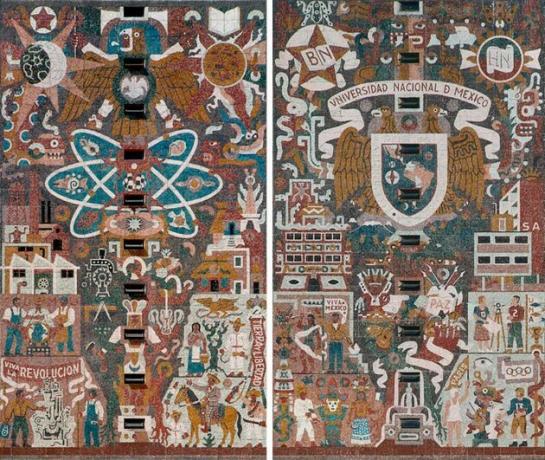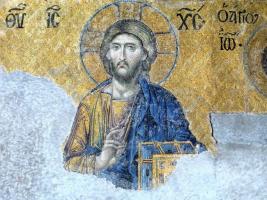Murals of the Central Library of the UNAM: analysis, explanation and meaning
One of the most emblematic works of the University City of the National Autonomous University of Mexico (UNAM) are the murals of the Central Library. Juan O'Gorman was responsible for its creation.
These murals were neither originally planned nor budgeted, but O'Gorman's insistence made it possible for them to be admitted.
The artist and architect would promise to charge very little in exchange for making the dream come true. What motivated you and what motivated those who allowed it? The conviction that the murals would be an open book on the history of Mexico and the place of knowledge in society.
Let's get closer to its meaning in this article.
Analysis of the murals of the Central Library of the UNAM

The UNAM Central Library is made up of two large volumes, one horizontal and the other vertical, following the models of the most emblematic and modern universities in the world. Its structure was made of volcanic stone typical of the area. In addition, it is composed of stained glass and amber-colored onyx surfaces.
The murals surround the four facades of the library: north, south, east and west. In total, these murals reach a surface area of 4000 meters.2. What a challenge the artist had to face when he decided to undertake this monumental project, made from colored stones, which he had to find in different regions of the country.
Each facade was dedicated to a different theme, in which O'Gorman would pour all his imagination and experience, together with the purpose of leaving testimony about the history, identity and values that make up the culture Mexican.
Therefore, the facades were assigned to each topic of interest, from which its name emerges:
- North facade: the pre-Hispanic past.
- South facade: the colonial past.
- Façade of the East: the contemporary world.
- Façade of the west: The university and present-day Mexico.
See also 5 keys to understanding the importance of Mexican muralism.
North facade: the pre-Hispanic past

The north wall corresponds to the representation of pre-Hispanic culture. In this mural, O'Gorman collects different mythical stories, such as the history of the origin of Tenochtitlán, as well as the duality of life and death.
The façade is structured with a central vertical axis and is then divided transversely by water currents. Ornamental motifs abound in the whole piece more than others.
O'Gorman refers to different symbols that are related to pre-Hispanic economic and cultural activities. At the center of the composition appears the foundation of Tenochtitlán.
In the whole of this facade you can see the representation of Quetzalcóatl (as a serpent), Tláloc and Huitzilopochtli.
South facade: the colonial past

In this mural O'Gorman exposes the Hispanic universe of the colonial period. He also makes a representation of the forms of social organization in force in this period.
Divide the panel into two halves, each with a circle. In the middle, an axis that like a tower rises to divide the mural. This central axis is a reference to the Habsburg house that ruled in Spain in those years.
The iconography of the mural includes a series of references to European culture from the era of the discoveries, such as the confrontation between Ptolemy's geocentric theory and heliocentric of Copernicus. It also refers to Greek religion and mythology.
Likewise, he highlights the representation of Tenochtitlán and the figures of the historical figures that marked that period, including Hernán Cortés and Fray Juan de Zumárraga.
Façade of the East: the contemporary world
The contemporary world is also present on the eastern façade of the library. O'Gorman cannot escape the fascination of the new scientific discourses that mark the time that he had to live. Thus, the atom is the heart of the representation, which appears as the principle of vital energy.
The left side is crowned with the red star of socialism. under him, the social and working-class order of Mexico is shown that is opening up to the social revolution.
The right side is crowned by an open book, and under it the representation of the rural world that ends in the evocation of the Mexican Revolution of 1910 and the portrait of Emiliano Zapata. This portrait is face to face with the scene of the socialist revolution on the left side.
At the top of the central column, it can be Cuauhtémoc and, in this, the dove of peace that will reconcile both worlds.

Façade of the west: the university and present-day Mexico
The fourth mural is dedicated to UNAM and contemporary Mexico. O'Gorman follows the same pattern of dividing the mural by a central axis.
Thus, the space is dominated in the center by the representation of the university's shield. O'Gorman represents the value of the intellectual institutions of the country. To do this, he introduces the initials of the National Library in the left corner and those of the National Newspaper Library in the right.
Right and left represents the academic, sports and recreational activities carried out at UNAM. This coexists with the representation of life and customs of popular Mexico.
University City of UNAM

The project of organization, design and construction of the University City had begun in 1943 in Coyoacán, Mexico City.
The Central Library itself began to be designed in 1944 with the participation of the architects Juan Martínez de Velasco and Gustavo Saavedra. In 1948, the architect and plastic artist Juan O'Gorman was invited to join the team.
With the facades of the library designed by O'Gorman, the set of murals that make the UNAM university campus so characteristic is completed. Thus, the murals of Diego Rivera (Olympic Stadium), David Alfaro Siqueiros (Rectory), Francisco Eppens (Faculties of Dentistry and Medicine) and José Chávez Morado (auditorium of the Faculty of Sciences).
The UNAM Central Library opened its doors for the first time on April 5, 1956.
In 2007, the University City of UNAM was named a World Heritage Site since 2007.
Who was Juan O'Gorman?

Juan O'Gorman was born in Coyacán, Federal District, on July 6, 1905. It would be his father Cecil O'Gorman, an engineer of Irish origin, from whom he learned to paint.
In addition to being a widely recognized easel painter, he was an important Mexican architect, graduated from the Faculty of Architecture at UNAM.
As an architect, he carried out works that today enjoy valuable recognition. He was the designer of dozens of elementary and technical schools in the Mexican State.
In addition, O'Gorman designed Diego Rivera's home-studio as well as what is now known as the Diego Rivera Anahuacalli Museum. This museum was a place that Rivera had dreamed of to provide spaces for the most varied cultural expressions, from plastic to musical. Today it houses the collection of pre-Hispanic figures of the artist.
As an architect he was influenced by functionalism and the work of the famous Le Corbusier. He later he was also permeated by the organic architecture of Frank Lloyd Wright.
Although he was primarily devoted to architecture and easel painting, O'Gorman also excelled with great success. in mural art, a fact that allowed him to gain experience for the visual development of the Central Library of the UNAM. He is considered, in fact, as one of the most important exponents of the second generation of Mexican muralism.
His artistic work earned him the National Art Prize in 1972.
Among his best-known works, we can mention:
- Murals of the Gertrudis Bocanegra Library in Pátzcuaro, Michoacán.
- Altarpiece of Independence and room of the Revolution in the National Museum of History of the Castle of Chapultepec.
- Cecil O'Gorman's House and Juan O'Gorman's House (demolished).
- Diego Rivera and Frida Kahlo House Study Museum.
- Murals Independence and Progress, I sing to the patria Y The liberators. Ministry of Communications and Transportation.
The artist committed suicide in 1982 in Mexico City after a severe depression.

University professor, singer, Bachelor of Arts (Cultural Promotion mention), Master of Literature Compared by the Central University of Venezuela, and PhD candidate in History at the Autonomous University of Lisbon.



